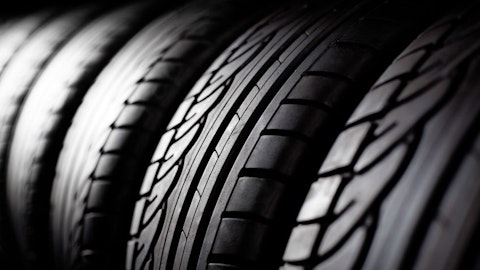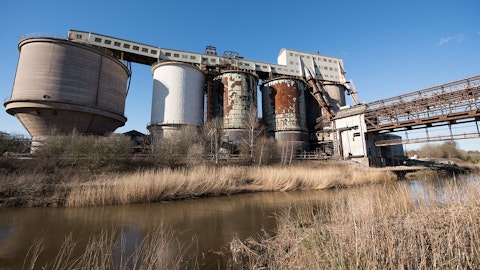William McLain: What you would expect is, again, that we expect around $800 million or less in 2024. To your point, obviously, we’re in the detailed engineering phases right now. And then France would be probably first out of the gate on long lead and then construction, closely followed by the second U.S. So we would expect 2025 we would be building CapEx, And it’s just going to depend on the timeline. So what I would say ,is it will be above $800 million and we’ll give you more firm answers on how we see 2025 when we actually get the project schedule set.
Michael Leithead: Great. Thank you.
Operator: Our next question comes from Josh Spector of UBS. Josh, please go ahead.
James Cannon: Hey guys, this is James Cannon on for Josh. Thanks for taking my question. In AFP, you called out in your guidance some [ROS] (ph) increasing in the fourth quarter. I believe you transfer some propylene from the CI segment. I’m assuming that might be a big part of it, but is there anything else we should be thinking about in that bucket?
Mark Costa: Yes, so we buy methanol, we buy ammonia, we buy — and we do have propylene-derived specialty products and coatings. So all those products are obviously are impacted by oil and overall market dynamics and creating some headwinds as those are increasing, especially from the oil change. It flows through and there’s just a lag in how the contract prices catch up to it. And so, you’ll have a headwind in the fourth quarter and that sequentially will then turn to a tailwind in the first quarter from the fourth quarter when those pricing adjustments catch up.
James Cannon: All right, great. Thanks. And then just on the specialty fluids that you called out some pull forward, can you give a little bit more color on what you saw there and kind of how much you expect to get pulled out of Q4?
Mark Costa: Yeah, so original guidance was we had some great fills on some LNG plants in the second quarter. We had originally expected that to be a bit more in the third, at the beginning of the year. So that — those fills were made. And so when you looked at the sequential drop from Q2 to Q3 we thought it would be about $30 million. But we had some additional fills show up in the third quarter, so that drop turned out to only be about $20 million. But the fluids sales for the year are changing, so that just means now that there’s an additional $10 million drop of that $30 million that will happen from Q3 to Q4. So that’s part of why AFP is declining sequentially into the fourth quarter. But overall, great business, and we really like these LNG fills.
There’s obviously a lot of construction — traditional chemical construction activity uncertainty, especially with [TNT] (ph) plants in China where a lot of these fills go. And it’s been great to diversify our exposure to that cycle with these LNG plants that also use a lot of heat transfer fluids. And I think as we look at that set of the markets, we see a lot of LNG facilities being built with the Ukraine-Russia situation and are very well positioned with our products for those fills, which also turn out to be pretty high value products for what they need to do. And we continue to really diversify our exposure into these places that are not as connected to what’s going on in China, which is great.
James Cannon: Great. Thanks.
Operator: Our next question comes from Kevin McCarthy of Vertical Research Partners. Kevin, the line is yours.
Kevin McCarthy: Yes, good morning. Mark, I didn’t see anything in the prepared remarks that you released on the subject of the UAW strike. Can you speak to whether or not that’s having any material impact? And if so, what you might be baking into the fourth quarter, or any auto-related commentary in general would be welcomed.
Mark Costa: Sure, so specifically UAW, the math on that is, it’s a pretty limited impact on us. About 20% of our auto and other business globally is in the United States. So our just overall exposure is not that high. And then you’re just talking about three brands of many that are in the US that are being impacted by the UAW. So it’s not a material impact. I would say that overall the auto business obviously has been a solid business for us. We’ve seen a lot of growth in the business in the US and Europe in particular for the interlayer business as well as the films business. I would note that China has been a challenge all year long, so we haven’t seen the growth we expected. We definitely thought we’d see some improved growth in the back half of the year, and that’s one of the things that didn’t play out as we thought from July to now in how we’ve adjusted our outlook down a bit.
And that’s particularly impacting our performance films business, which is an important business in China and we’re not seeing sort of the growth that we expected there and even some contraction right now at the sales level in some parts of that Chinese business. So, overall, I’d say it’s been a great business, we expect it to be better next year than this year, but it’s — there’s a lot of ups and downs going on across the different markets.
Kevin McCarthy: Thank you for that. And then secondly, if I may, perhaps for Willie. I think earlier this year you had guided to a cost headwind related to pension and OPEB of $110 million, if my notes are correct. Is that still the case? And more importantly, what happens to that line item moving forward into 2024? Does it come back down or would you point to a different trajectory?
William McLain: Yes, so ultimately that number is set for the year at the beginning of the year so the $110 million is just coming through quarterly as we expected. That gets market to market at the end of the year. So there will be, I call it, a gain loss from asset returns as well as interest rates. And right now as we look at where rates are, assets and returns, it’s probably a modest headwind if you were to market to market right now, but again we’ll give you an update. We don’t expect anything material that will update you at year end.
Kevin McCarthy: And any insight on 2024, Willie?
William McLain: From a pension standpoint, we expect it to be a modest headwind if we look at it right now. That will change a lot depending on how rates finish up for the year.
Operator: Our next question comes from Laurence Alexander of Jefferies. Laurence, please go ahead.
Unidentified Analyst: Hi, good morning. This is [Dan Rizwan] (ph) on for Lawrence. Thank you for taking my question. I don’t know if I missed this or not, but so for the second plant in the US and the plant that you’re building in France, do we think of those as when they are up and running to be $150 million in EBITDA additions as well? Or is it greater scale or less than that? Or how should we think about it long term?





